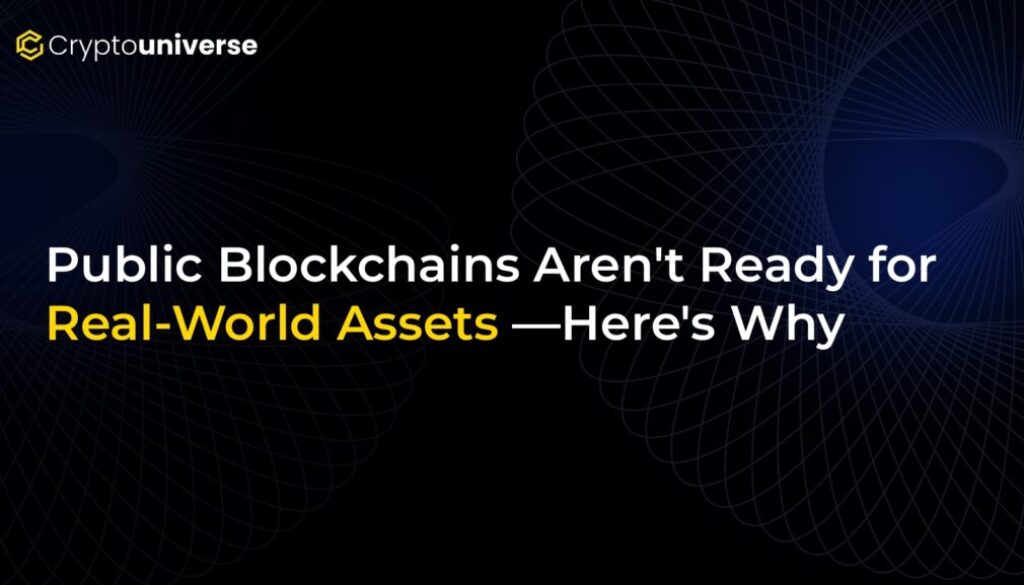Public Blockchains Aren’t Ready for Real-World Assets—Here’s Why

The Trillion-Dollar Promise Meets a Technical Reality
When BlackRock, the world’s largest asset manager, launched its BUIDL fund—a tokenized U.S. Treasury fund on Ethereum—the crypto world buzzed with excitement. This wasn’t just another experiment; it was a clear signal that Real-World Assets (RWAs) were going mainstream. With the market growing from a mere $100 million in 2023 to a projected $7.3 billion, the convergence of traditional finance (TradFi) and crypto seems inevitable.
However, a closer look at how these projects are structured reveals a critical friction point. The very public blockchains celebrated for their permissionless nature, like Ethereum, are fundamentally misaligned with the stringent demands of institutional finance. To make it work, giants like BlackRock are relying on a patchwork of off-chain services and centralized intermediaries—reintroducing the very systems blockchain was meant to disrupt. This isn’t just a philosophical compromise; it’s a sign that the underlying infrastructure isn’t ready for primetime.
The Fundamental Mismatch: Why Public Chains Falter
Public, general-purpose blockchains like Ethereum and Solana were designed for decentralization and open innovation. While revolutionary, this design philosophy creates significant hurdles for regulated institutions that prioritize security, compliance, and control above all else. Here are the core issues:
1. The Settlement Uncertainty
In traditional finance, a transaction is final the moment it settles. There’s no ambiguity. Public blockchains like Ethereum, however, operate on probabilistic finality. This means there’s a small but non-zero chance that a recently confirmed transaction could be reversed or reorganized. For a DeFi trader, this might be an acceptable risk. For a multi-billion dollar asset manager bound by strict legal standards, any chance of reversal is a non-starter. Institutions require instant and irreversible settlement, a feature most public chains cannot natively guarantee.
2. The Compliance Conundrum
Financial institutions are legally obligated to know their customers (KYC) and prevent money laundering (AML). Public blockchains are, by design, pseudonymous. To bridge this gap, RWA projects are forced to bolt on compliance layers using third-party services or complex smart contracts. BlackRock’s BUIDL fund, for example, handles all its KYC verification entirely off-chain through a separate company. This approach is not only inefficient and expensive but also creates a fragile system where compliance is an afterthought, not a core feature.
3. The Volatile Fee Structure
Imagine a bank trying to forecast its quarterly operational expenses when its transaction costs fluctuate wildly day-to-day. This is the reality of using a public blockchain where fees (gas) are paid in a volatile native token like ETH. Institutions need predictable, stable costs. They prefer to pay for services in stablecoins or fiat equivalents, but native support for this on general-purpose chains is limited and inconsistent.
4. The Lack of Operational Control
Regulated entities need fine-grained control over their operations. This includes the ability to freeze assets in response to a court order, halt transactions during a security incident, or maintain detailed, real-time audit logs for regulators. These are not “nice-to-have” features; they are fundamental requirements. Public blockchains, built on the principle of unstoppable code, lack these native control mechanisms, forcing institutions to seek out complex and often centralized workarounds.
The Path Forward: Purpose-Built Infrastructure for RWAs
The limitations of public blockchains cannot be solved with simple upgrades or middleware “band-aids.” The institutional demand for tokenization is here now, and it requires a new approach. This has sparked the rise of a new generation of blockchain infrastructure: application-specific blockchains, or “appchains.”
Unlike general-purpose chains, appchain frameworks are modular. They allow institutions to build dedicated blockchains tailored to their specific needs. This approach solves the core issues head-on:
- Compliance by Design: KYC, AML, and other regulatory rules can be embedded directly into the blockchain’s core logic. This makes compliance an automated and integral part of every transaction, not an external process.
- Instant and Deterministic Finality: These chains can be engineered to provide the irreversible, immediate settlement that financial operations depend on.
- Stable and Predictable Fees: Institutions can configure their appchain to use stablecoins or other predictable assets for transaction fees, simplifying accounting and financial planning.
- Full Operational Control: A dedicated chain provides the granular control needed for institutional-grade applications, including built-in tools for asset management, emergency controls, and auditable logging.
Building the Future of Finance on the Right Foundation
The tokenization of real-world assets represents a monumental shift in finance, but placing these high-value, regulated assets on infrastructure that wasn’t designed for them is like building a skyscraper on a foundation of sand. The initial wave of RWA projects has successfully proven the demand.
Now, the next era of adoption will be defined by the shift to purpose-built infrastructure. The institutions that recognize this and build on dedicated, compliant, and controllable blockchains will not only mitigate risk but will also become the architects of a more efficient and transparent global financial system. The future isn’t about forcing TradFi onto crypto’s native rails; it’s about building new rails specifically designed for the journey.


